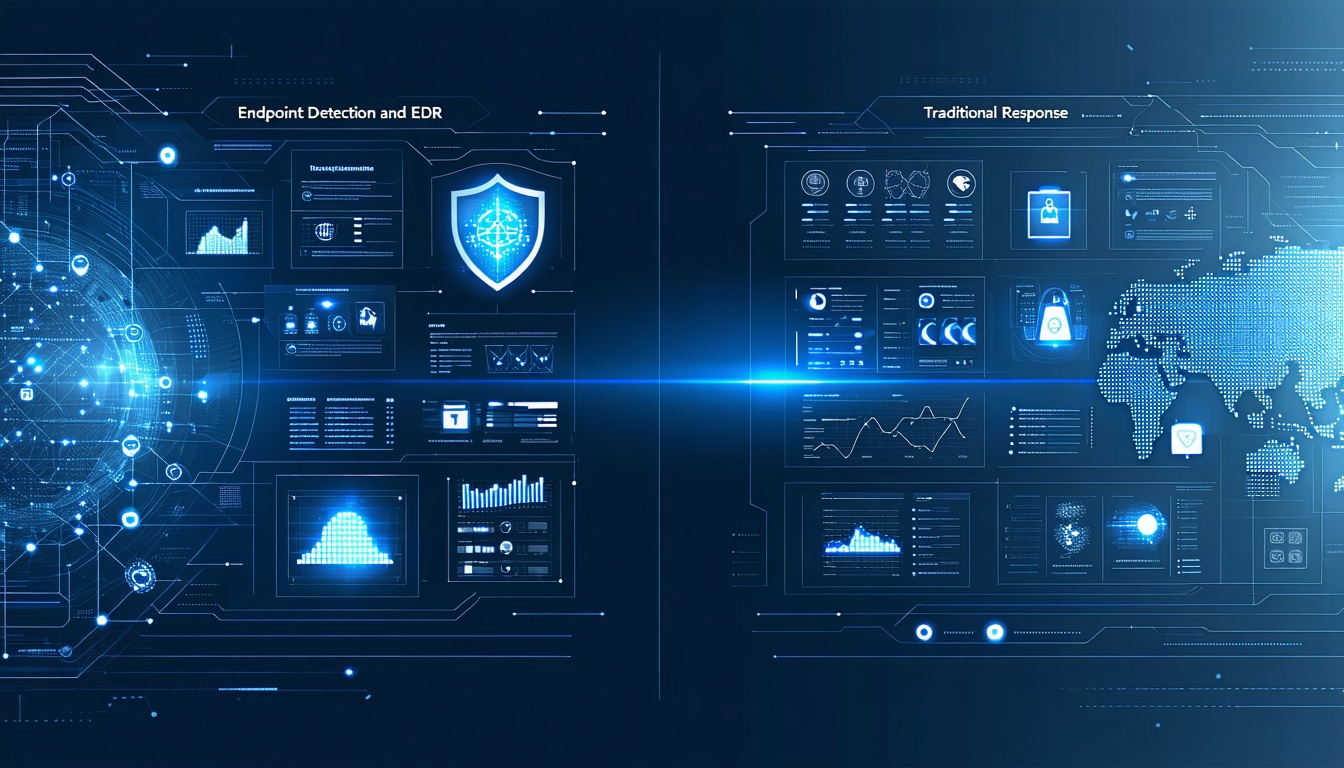The debate around endpoint detection and response vs antivirus protection is central to modern cybersecurity strategies. Organizations may evaluate the relative merits of each approach when designing a layered defense. Traditional antivirus solutions focus on signature-based scanning to block known malware across devices. In other cases, endpoint detection and response platforms provide continuous monitoring, behavioral analytics, and automated containment. To guide strategic decision-making, this analysis examines core differences in detection techniques, remediation capabilities, threat coverage, and operational considerations.
Defining Endpoint Protection Solutions
Traditional Antivirus Overview
Traditional antivirus software operates by scanning files and programs for known malicious code or signatures. Signature-based, heuristic-based, and behavioral-based detection methods form the core of these tools (Palo Alto Networks). As a first response layer, antivirus solutions block common viruses, worms, and trojan horses. Many implementations also include email and web shields to intercept threats at entry points. That approach remains effective against widely encountered malware variants, though it can struggle with novel or obfuscated attacks.
Evolution to Endpoint Detection
Endpoint detection and response platforms build on traditional methods by continuously monitoring endpoint activities and storing detailed telemetry in an EDR database. This solution offers context-rich data on process executions, network connections, registry changes, and file modifications. Through integration with external intelligence sources, modern next gen EDR systems apply behavioral analytics and machine learning to detect indicators of attack (IOAs) rather than relying solely on known signatures (CrowdStrike). This shift enables the identification of sophisticated threats that may evade perimeter defenses.
Contrasting Detection Techniques
Signature-Based Scanning
Antivirus tools primarily use signature-based detection, matching file hashes or patterns against a maintained library of known malware signatures. This method offers high performance and low resource overhead. However, it cannot identify previously unseen threats without updated signature definitions. In many cases, rapid malware evolution and polymorphic techniques can render signature lists out of date.
Behavioral And Anomaly Analysis
Endpoint detection and response solutions leverage behavioral and anomaly-based analysis to identify emerging threats. By analyzing billions of events in real time, EDR systems can surface suspicious activities such as unusual process nesting or abnormal network communications (CrowdStrike). Machine learning models refine detection rules continuously, reducing false positives and improving accuracy against fileless or stealthy attacks.
Key Detection Differences
Reviewing Remediation Capabilities
Automated Containment Processes
When a threat is detected, endpoint detection and response platforms can isolate the compromised host from network activity instantly, allowing security teams to investigate without risk of lateral spread (CrowdStrike). This network containment feature accelerates incident response and limits potential damage. Traditional antivirus solutions typically quarantine or delete malicious files, but they lack the ability to enforce network segmentation at the endpoint level.
Alerting And Forensic Context
EDR solutions generate detailed alerts that include contextual information on the affected endpoint, the sequence of malicious actions, and indicators of compromise. This level of forensic insight helps security analysts prioritize critical incidents and trace root causes. Reporting dashboards consolidate telemetry, supporting continuous improvement of detection logic and response playbooks. Antivirus logs, by comparison, often provide only basic scan results without deep process context.
Considering Coverage Scope
Known And Emerging Threats
Antivirus software excels at blocking widespread malware families using signature, heuristic, and behavioral-based detection (Red Canary). Yet sophisticated ransomware, advanced persistent threats, and zero-day exploits may evade traditional defenses. EDR platforms enhance coverage by hunting for unknown adversaries and uncovering indicators of compromise even after a breach (Microsoft).
Remote And Hybrid Endpoints
With the rise of remote and hybrid work environments, organizations require continuous visibility across geographically dispersed devices. Endpoint detection and response technology records and analyzes data from laptops, mobile devices, and virtual desktops in real time, ensuring security teams can monitor and respond regardless of location (Microsoft). Small enterprises with limited security staff may consider EDR for Small Business offerings, which often include managed services to fill expertise gaps.
Evaluating Deployment Impact
Resource And Cost Requirements
Antivirus solutions generally demand minimal infrastructure and can be deployed rapidly with low management overhead. They may suit organizations with constrained budgets or without dedicated security teams. In contrast, EDR platforms collect large volumes of telemetry, requiring storage, analytics capabilities, and skilled personnel. For some, a Managed EDR service offers a compromise by outsourcing day-to-day monitoring and response to specialized providers.
Integration And Management Overhead
Endpoint detection and response implementations often integrate with existing security information and event management systems to enhance centralized incident workflows. IT leaders may review comparisons in SIEM vs EDR to determine the most effective architecture. Successful deployment depends on cohesive processes and clearly defined roles for threat hunting, alert triage, and remediation.
Scalability And Adaptability
As threats evolve, organizations may expand from standalone EDR to broader extended detection and response solutions. A comparison of EDR vs XDR highlights how cross-layer integration can deliver unified visibility across networks, cloud workloads, and applications. Scalability considerations also encompass cloud-based deployment models, which allow elastic computing resources to adapt to changing telemetry volumes.
Conclusion
The contrast between antivirus and endpoint detection and response reflects a broader shift toward proactive, intelligence-driven security strategies. Traditional antivirus remains a foundational layer, offering efficient protection against common threats. Meanwhile, EDR platforms provide real-time monitoring, deep forensic context, and automated containment, enabling detection of sophisticated and emerging attacks. Organizations may consider a layered approach that combines the strengths of both solutions. From signature-based scanning to behavioral analytics, each technology contributes unique capabilities. By aligning detection and remediation strategies with business objectives, IT leaders can achieve a balanced security posture that adapts to evolving risk landscapes.
Need Help With Choosing EDR Or Antivirus Protection?
Need help with evaluating the right endpoint security solution for complex environments? We specialize in identifying the optimal balance between traditional antivirus and advanced detection platforms. Through comprehensive assessments, we match organizations with solutions that align to technical requirements, budget constraints, and operational maturity. Connect with us to explore how a tailored security strategy can strengthen threat resilience and streamline incident response.






